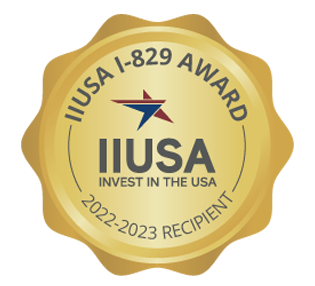Navigating the I-485 Adjustment of Status for EB-5 Investors Residing in the U.S.
Form I-485: Adjustment of Status (AOS) for EB-5 Investors Residing in the U.S.
Who Can File Concurrently?
Form I-765: Work Authorization and Form I-131 Advance Parole
Adjustment of Status (AOS – Form I-485) filing process
Adjustment of Status for International Students
Adjustment of Status for B-1/B-2 Visa Holders
The EB-5 visa program, established in 1990, is one of the oldest and most popular investment migration programs in the world. This program has attracted thousands of foreign investors from across the globe by offering a direct pathway to U.S. permanent residency.
Investors, whether already residing in the United States on a non-immigrant visa or living abroad, can benefit from the EB-5 program. By investing a minimum of $800,000 in a designated EB-5 targeted employment area (TEA) project and creating the required number of jobs, investors and their immediate family members can become eligible for U.S. permanent residency, commonly known as a Green Card.
The EB-5 program not only provides an opportunity for investors to secure their future in the United States but also plays a significant role in promoting economic growth through job creation and capital investment.
Learn more about EB-5 Visa:
For H-1B, L, or E2 visa holders, as well as international students, the EB-5 visa offers a direct route to permanent U.S. residency without the uncertainty of visa renewals and employer dependence. This program enables professionals and students to transition from temporary status to permanent residency within months of beginning the process, granting them the freedom to seek employment and pursue broader career opportunities within the U.S. In addition, the EB-5 program allows investors to live and work anywhere in the country, with their families joining them and enjoying the same Green Card benefits.
Learn more about Advantages of EB-5 Visa:
- Advantages of EB-5 Visa for H-1B Visa Holders
- Advantages of EB-5 Visa for International Students
- Advantages of EB-5 Visa for E-2 Business Visa Holders
Form I-485: Adjustment of Status (AOS) for EB-5 Investors Residing in the U.S.
Adjustment of Status (AOS) or Application to Register Permanent Residence through Form I-485 allows EB-5 applicants residing in the U.S. to transition from their current status to permanent residency without leaving the country. Approval of Form I-485 means investors can remain in the country while their EB-5 application (Form I-526E) is processed. This process is known as concurrent filing, and is one of the recent advantages of the EB-5 Reform and Integrity Act of 2022 (RIA).
Before the RIA,there was no opportunity to file Form I-485 and Form I-526 concurrently. EB-5 investors had to endure a years-long wait for the adjudication of Form I-526, and only after its approval could they apply for Adjustment of Status (AOS), work authorization, and advance parole.
The RIA now permits EB-5 applicants already in the U.S. to apply for adjustment of status at the same time they file their EB-5 immigrant investor petition. This concurrent filing significantly speeds up the immigration process, allowing investors to transition more quickly to permanent residency and gain employment authorization and travel benefits sooner.
Who Can File Concurrently?
According to USCIS, most employment-based applicants and their eligible family members are eligible for concurrent filing when a visa is immediately available or “current.” H-1B, L1, F-1, TN or E-2 visa holders based in the United States can file EB-5 Immigration petitions concurrently with their AOS. Please consult your immigration attorney whether concurrent filing is available in your case.
Form I-765: Work Authorization and Form I-131 Advance Parole
An EB-5 investor can also file Form I-765, the application for work authorization (employment authorization document or EAD), and Form I-131, Advance Parole, which allows applicants to travel abroad while their I-485 (Adjustment of Status) is pending.
Adjustment of Status (AOS – Form I-485) filing process
The Form I-485 application for EB-5 investors is usually submitted by their immigration attorney, though the USCIS website offers a checklist of the necessary supporting documents. Additionally, the I-485 application requires a filing fee of $1,540 and a biometrics fee of $85, with further details and the application form available on the USCIS website.
The application fee amount recently has been increased by USCIS. Read news ‘EB-5 Visa Petition Filing Fees Increased by 200% Starting April 1, 2024’
To minimize delays in the processing of Form I-485, USCIS recommends filing Form I-693, Report of Immigration Medical Examination and Vaccination Record, concurrently with Form I-485, along with all necessary initial evidence and supporting documents. According to USCIS, submitting these forms together can reduce the likelihood of receiving a Request for Evidence (RFE), which could otherwise postpone the adjudication of an investor’s case.
Adjustment of Status for International Students
The F-1 visa is designated for international students entering the U.S. with the specific purpose of pursuing academic studies without the intent to immigrate. Like other non-immigrant visas, F-1 visa holders are also subject to the 90-day rule.
This rule stipulates that if a student files for an EB-5 immigration petition and Adjustment of Status (AOS) within 90 days of entry, USCIS may view this as a misrepresentation of their original non-immigrant intent. Such actions taken within this timeframe may result in the denial of the EB-5 petition, as it suggests that the student had a preconceived plan to adjust status that was not disclosed at the time of entry.
However, international students on an F-1 visa can legally pursue an EB-5 application and adjust their status if they choose to do so after these initial 90 days have passed. It’s important for students to consider the timing of their application carefully, particularly because of the Advance Parole processing period, which is crucial for those who may need to travel internationally. This application, which can be filed concurrently with the AOS, typically takes about 3 to 6 months to process. During this period, students are advised not to leave the U.S. until they receive their Advance Parole, as doing so could jeopardize their AOS application. Your immigration attorney will advise based on your case, timing and current status.
Adjustment of Status for B-1/B-2 Visa Holders
The B-1/B-2 visa, commonly known as a tourist visa, is designated for those who intend to visit the United States temporarily and without any immigration motives. This visa requires holders to adhere to the 90-day rule, which underscores that visitors must enter the U.S. with a specific purpose aligned with their non-immigrant status and a clear intent to leave upon completion of their visit. This rule is critical in maintaining the integrity of the visa’s non-immigrant classification.
If an individual enters the U.S. on a B-1/B-2 visa and files for an EB-5 immigration petition and Adjustment of Status (AOS) within 90 days of their arrival, USCIS may perceive this action as deceptive. Since the applicant initially declared no immigration intent upon entry, a change of intent within such a short period could suggest that the initial declaration was not truthful.
Furthermore, the 90-day threshold is considered inadequate for an individual to legitimately reconsider their initial non-immigrant intentions and pivot towards pursuing immigration objectives. Thus, actions taken within these 90 days could lead to a denial of the EB-5 petition and are unadvisable by many attorneys, however, please check with your immigration attorney for the circumstances impacting your case.
For a Free Consultation with an Experienced EB-5 Professional Enter your Details
Disclaimer
The opinions expressed in this video/blog post are solely those of the presenter/author. The information provided herein is for general informational purposes only and should not be considered as professional or legal advice. The presenter/author or Golden Gate Global do not endorse or take responsibility for any actions taken based on the information presented herein. Viewers/readers are advised to seek appropriate professional advice before making any decisions or taking any actions based on the content of this video/blog post.


